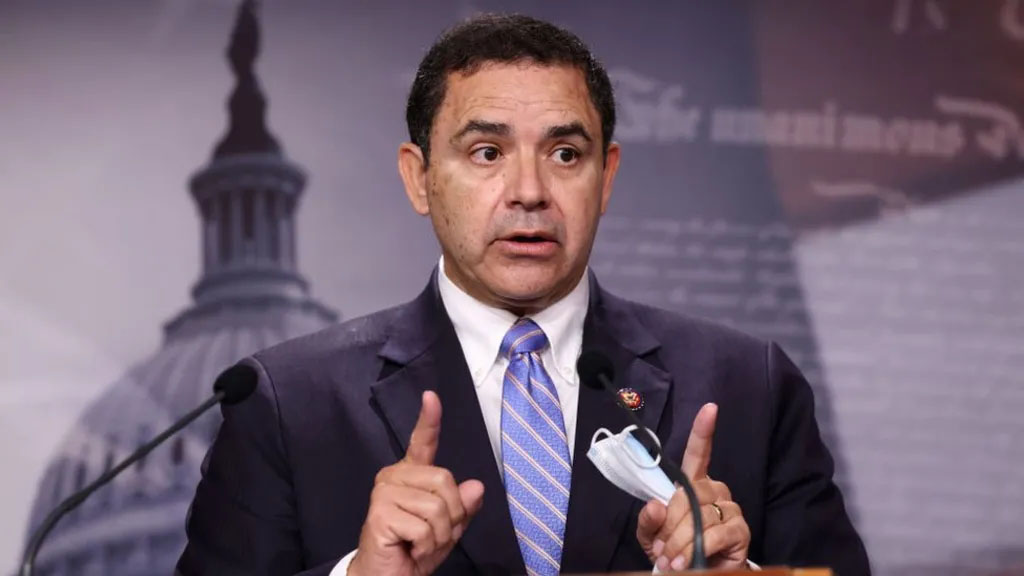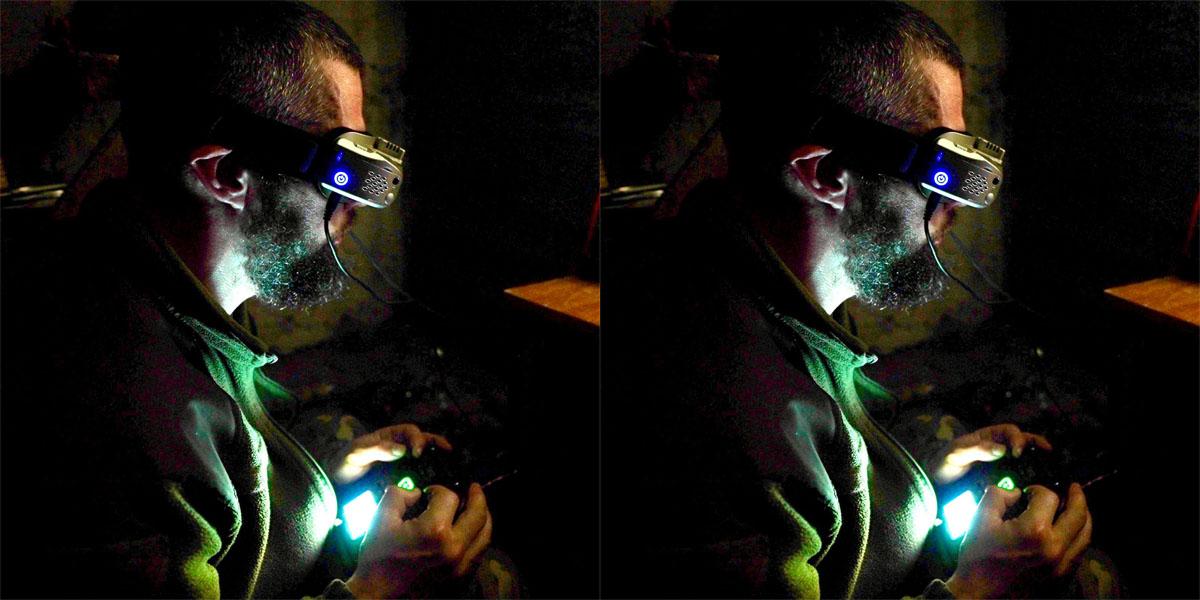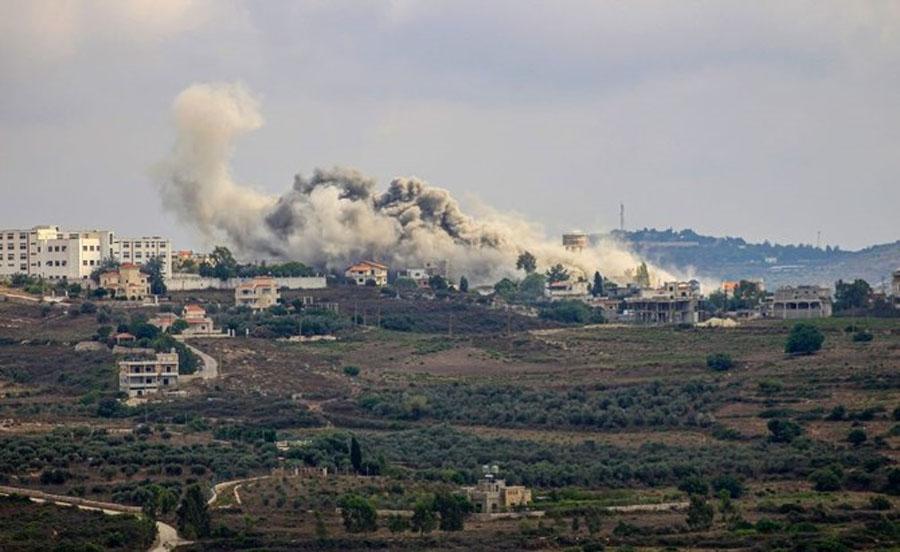International
US congressman, wife charged with $600,000 bribe tied to Azerbaijan, Mexican bank

US congressman, wife charged with $600,000 bribe tied to Azerbaijan, Mexican bank
US congressman Henry Cuellar and his wife have been charged with accepting around $600,000 (£478,000) in bribes, the justice department says.
It is alleged the couple corruptly received money from an Azerbaijani government-owned oil company and a Mexican bank.
The Texas Democrat has denied the charges in a statement.
The couple were bailed after appearing in court in Houston. If found guilty, they could face decades in prison.
“I want to be clear that both my wife and I are innocent of these allegations,” Mr Cuellar, 68, said on Friday.
The couple are each charged with multiple counts of conspiracy, bribery, wire fraud, money laundering and violating a ban on acting as agents of a foreign organisation.
The justice department said bribes were laundered from 2014-21 via a series of “sham consulting contracts” through middlemen and front companies owned by Imelda Cuellar, 67.
In exchange for the money, the indictment alleges Mr Cuellar agreed to influence US foreign policy in favour of Azerbaijan and push measures beneficial to the bank headquartered in Mexico City, including changes to money-laundering laws and attempts to block regulation of the payday lending industry.
The Cuellars allegedly used the proceeds from the bribery schemes to pay off a number of debts and make purchases for their family.
READ ALSO:
Among the outgoings were more than $58,000 (£46,000) on credit card payments, some $11,000 in car payments, $18,000 at wholesale stores and $12,000 for a custom gown, according to the indictment.
Senator Robert Menendez, a New Jersey Democrat, faces similar charges. He and his wife are accused of taking bribes in exchange for the senator using his influence to benefit the governments of Egypt and Qatar.
In the statement released by his office, Mr Cuellar vowed to keep campaigning for re-election in November.
“Before I took any action, I proactively sought legal advice from the House Ethics Committee, who gave me more than one written opinion, along with an additional opinion from a national law firm,” he said.
“The actions I took in Congress were consistent with the actions of many of my colleagues and in the interest of the American people.”
Mr Cuellar was a lawyer and former customs broker before entering politics. He was first elected to Congress in 2004 and is a former co-chair of the Congressional Azerbaijan Caucus.
Hakeem Jeffries, Democratic party leader in the House of Representatives, said Mr Cuellar would take a leave of absence from his post on a homeland security subcommittee while the case continues.
Mr Cuellar’s home and campaign office in Laredo were raided in January 2022.
Authorities said at the time the raid was part of a federal investigation into Azerbaijan and US businessmen who have links to the country.
Mr Cuellar is widely considered a centrist and has been described as the lone anti-abortion House Democrat.
In 2022, he narrowly survived a primary challenge from a progressive candidate, Jessica Cisneros, who once worked as an intern in his office.
US congressman, wife charged with $600,000 bribe tied to Azerbaijan, Mexican bank
BBC
International
Court documents reveal Diddy allegedly paid $1m to kill 2Pac

Court documents reveal Diddy allegedly paid $1m to kill 2Pac
American music mogul Sean Combs, known as Diddy, has been implicated in the 1996 murder of rapper Tupac Shakur.
According to new court documents obtained by the U.S. Sun, Diddy is accused of paying $1 million for Shakur’s assassination through suspect Duane “Keefe D” Davis, who was arrested for the murder last year.
In the documents filed on July 18, Diddy is mentioned 77 times under various aliases including Puffy, Puff Daddy, Puff, and his legal name, Sean Combs. Davis reportedly testified that Diddy played a role in Tupac’s murder, suggesting that Diddy paid Eric Von Martin a million dollars for the killings.
READ ALSO:
- Lagos Uber driver arrested for challenging police officer at Zebra crossing
- PSG snub Osimhen, table €60m for Rennes Doue
- Police arrest Kano banker, three others for currency fraud
Davis claimed that Diddy told him and a group of about 45 people how he “would give anything” for Knight’s “head” because he was “scared” of him and had issues with Shakur, who had released a diss track about him. Prosecutors filed these documents to oppose Davis’ latest bail request, which was rejected last month due to concerns about the source of the $112,500 bail bond.
It remains unclear whether Diddy will be subpoenaed or indicted as part of the case.
Court documents reveal Diddy allegedly paid $1m to kill 2Pac
International
Ukraine faces war bleak future as drones open new battlefront

Ukraine faces war bleak future as drones open new battlefront
The black box sits on the army truck dashboard like a talisman, its tiny screen lighting up with warnings when Russian drones are above us. We are driving fast along a country road in the darkness near the front lines outside Kharkiv.
Like many in this war, the soldiers inside have come to revere the little cube they call “sugar”; it warns of the unseen dangers above.
On the vehicle’s roof are three mushroom-shaped antennas that make up separate drone-jamming equipment. The car emits an invisible aura of protection that will thwart some, but not all, of the Russian attack drones patrolling the skies above this battlefield.
“It has detected the Zala Lancet Russian drones,” says Senior Lt Yevhenii, 53, from the front passenger seat, describing one of the most powerful long range Russian drones and its targeting drone. “Is that why we’re driving so fast?” I ask, aware that the drone-jamming antenna is useless against a Lancet.
“We’re not a priority for them, but it’s still better not to slow down because it’s very dangerous,” says Yevhenii, from the Khartia Brigade of Ukraine’s National Guard.
The jamming equipment blocks roughly 75% of frequencies that drones use to communicate with their operators, but some like the Lancet are difficult to block because they are entirely autonomous once their target has been marked. Because of the Lancet’s power, it tends to be used on larger targets, such as armoured vehicles or infantry positions, the Ukrainians say.
Almost none of this technology was here in Ukraine a year ago; now it is commonplace. Drones, which were once peripheral to the war are a central component for both sides, alongside infantry and artillery as Ukraine struggles to hold back Russian advances.
Ukraine has been thrown into the bleak future of war, where within minutes individual soldiers, fast-moving vehicles and trench positions can be precisely targeted. Drones have civilians in their sights too: about 25 from Russia attacked Kharkiv on Tuesday night, although most were intercepted.
READ ALSO:
- Methodist Church disowns group promoting LGBTQ in Gombe
- Hundreds killed in first 10 days of hostilities in south Lebanon
- US Congress cheers Netanyahu address, protesters gather to denounce it
Ukraine’s army is fighting back with its own drones, and there are dozens across this stretch of front line. One Ukrainian soldier tells me every day they kill 100 Russians.
The last images from drone cameras are usually of men panicking, their arms flailing, weapons firing before they are killed. The brigade’s 37-year-old drone commander, who goes by the call sign Aeneas, says that without shelter in a building there is little chance of survival – for Russians, and his men too.
“It’s the new way or a new path in modern war. In 2022 it was only infantry war and today one half is only a war of drone, a battle between Russian drones and ours,” he says.
The move to drone warfare is a combination of necessity and innovation. Drones are in plentiful supply, even though when armed they lack the explosive fire power of artillery.
Ukraine has consistently run short of artillery shells, and its allies have been slow to produce and supply them. But a Drone Coalition of Ukrainian allies has pledged to supply the country with a million drones this year.
Russia has made its own innovations on the battlefield too, using an older technology, and the village of Lyptsi, just six miles (10km) from the Russian border, has paid the price.
It was devastated by glide bombs – Soviet-era “dumb bombs” fitted with fins and a satellite guidance system. Some are as large as 3,000kg (6,600lbs) and, when launched from aircraft, glide onto Ukrainian infantry positions and towns to highly destructive effect.
One woman named Svitlana, who was driven out of Lyptsi by these attacks, told us: “Everything was exploding all around. Everything was burning. It was scary there. It was impossible to even get out of the cellar.”
Aeneas takes us on a tour of his drone teams, embedded along the front line in Lyptsi. Every vehicle we encountered near there was fitted with drone-jamming equipment; but the jammer’s protection ends when you exit the vehicle.
It’s dangerous to be caught out in the open, so we follow Aeneas running across the rubble for cover. All the while the BBC’s own drone detector calls out calmly into an earpiece: “Detection: multiple drones, multiple pilots. High signal strength.”
Out of breath, we make it to the drone unit’s underground base beneath a ruined building, where we are introduced to two operators, Yakut and Petro. There are drones on every surface, next to a frying pan with their evening meal. They get through many hundreds of drones in a month, as most are single-use and detonate on their target.
Their weapon of choice is the First Person View (FPV) drone, which carries a payload of between 1kg (2.2lbs) and 2kg of explosive, packed with shrapnel. The drones are modified off-the-shelf models which have cameras to send video back to their remote operators. “We call them celebration drones in Ukraine. They were used to film weddings and parties before the war,” Aeneas says.
READ ALSO:
- HIV prevention: Experts excited about trial results of injectable Lenacapavir
- Hardship: Nigerian students gear up for nationwide protest
- Edo couple who trafficked woman to Dubai jailed 5 years
I watch on a screen in real time beside Yakut who is fixed in concentration flying a drone manually to a target, across open fields and woodland. “He knows every puddle, every tree in the area,” Petro says.
The FPV drone approaches a building where a Russian soldier is believed to be hiding. It flies through an open window and detonates, the operator’s screen turning to static as the signal is lost. At the same time, another drone team is targeting a Russian Tigr light-armoured vehicle and scores a direct hit, captured by a second surveillance drone that’s watching from above.
The men stay on these positions, flying missions day and night, for up to five days at a stretch and spend as little time outside as possible. Their biggest fear is glide bombs: one landed nearby earlier that week, and the whole building shook. What happens if there’s a direct hit? I ask Petro. “We die,” he replies.
Aeneas shows me a recording from earlier in the week: a Russian soldier is caught in the open and the unit’s drone has him in its sights. The soldier notices it and runs for cover, hiding in a drainage culvert by the roadside. Slowly the drone lowers to its level, checking one side of the drainage pipe, then going around the other side, where the soldier is hiding. It detonates and the man is blown out, dying by the roadside. “He was divided into two parts,” explains Aeneas.
The operators are cool and dispassionate, almost clinical in their targeting and killing. They are as far as three miles (5km) away from their targets, one step removed from the immediate blood and guts of the battlefield. But encountering these weapons on the frontline is nerve-wracking.
A few days later, after dark, at an infantry trench close to Russian positions, a unit commander tells me he believes the Ukrainians have the upper hand in drone warfare, the Russians the advantage with glide bombs.
Russia also has the advantage in drone numbers: six for every Ukrainian one, although the drone teams I was with say they have the technological edge and are quicker at finding ways to counter-attack and jam Russian drones.
The trench is in a wooded copse, surrounded by fields, a thick canopy of trees provides cover.
But as we are speaking a Russian FPV drone is detected and begins to move closer to the position. The few dim lights, mostly phone screens, are turned off in the trench, and the men sit silently as the drone’s approach gets louder. We hold our breath as it hovers overhead. For what seems like an age, no one dares move. But then the drone moves on, in search of another target.
The largest drone in the brigade’s arsenal is the Vampire, which with its six rotors is the size of a coffee table. Again we join Aeneas on another mission in Lyptsi after dark, under the sound of constant artillery fire, where we meet the heavy bomber team. They work to attach the bomb to the drone.
“Ten kilograms, the Russians call this drone the Bogeyman,” says Aeneas. It’s payload is powerful enough to take out their intended target, a Russian command post, they say.
As the men work, a Russian drone makes a number of passes overhead: each time it does, the soldiers retreat into the basement, wait for the all-clear, then resume the assembly. As the drone takes off into the night in a cloud of dust, they watch its progress again from a second surveillance drone.
Just then, with barely any warning, we see on the drone’s thermal camera three Russian glide bombs detonating over the Ukrainian position, over a kilometre away. The shock waves are visible: seconds later they reach our location and the house around us shudders violently.
Ukraine’s allies know that by supporting the drone effort, they are helping the country’s cause, but it isn’t simply an act of charity.
The head of the British military, Admiral Sir Tony Radakin, has said that the UK’s armed forces can learn from Ukraine how to fight future wars. He said in a speech on Tuesday that he wants the Army to have “battalions of one-way attack drones”.
Aeneas and his men know this. As we leave their position, a Russian drone returns and we drive off at speed into the darkness. In the truck he tells me: “No one is fighting war this way – they are learning from us. This will be the future war.”
Ukraine faces war bleak future as drones open new battlefront
BBC
International
Hundreds killed in first 10 days of hostilities in south Lebanon

Hundreds killed in first 10 days of hostilities in south Lebanon
BEIRUT: Thousands of attacks on South Lebanon have resulted in the death of nearly 540 people and hundreds more injured since hostilities began on July 15, according to MP Fadi Alama, the head of the Foreign Affairs Committee in the Lebanese parliament.
The MP said 538 people had died and 1,850 injured in the 5,736 attacks.
The Foreign Affairs Committee met on Wednesday with several ambassadors from the EU, Switzerland, Norway, Britain, and Canada to present the results of the ongoing Israeli attacks on southern Lebanon, as part of preparations for “the government’s work in the post-ceasefire phase.”
MP Alama said that “representatives of diplomatic missions and international organizations were surprised when we talked about 1,800 hectares intentionally burned by the Israeli enemy. They were also surprised by the number of schools that were targeted and the number of students who were unable to complete their education and moved to other places. Additionally, they were informed of the 28,000 new families who have been displaced from areas that are being targeted daily.”
The parliamentarian said there was urgency for the government to develop a plan and a roadmap as soon as possible.
MP Wael Abu Faour, a member of the Parliamentary Foreign Affairs Committee, stated that “the human, health, urban, agricultural, and environmental losses as a result of Israeli attacks have become enormous. Initial estimates from Lebanese institutions indicate a cost of approximately two $2 billion so far, in addition to other damages and losses.”
Abu Faour said: “This is a new challenge for the Lebanese state that must be dealt with in Lebanon’s Arab and international relations. The state is bankrupt and unable to bear such responsibilities, but at the same time, it cannot abandon its responsibilities towards its citizens regardless of any controversial local political considerations regarding the feasibility of war or its justifications among some parties.”
Hostilities between Hezbollah and the Israeli army continued on Wednesday. According to Israeli media, “43 settlements were evacuated in the north, (and) more than 1,500 buildings, cars, and infrastructure were damaged in the north. Additionally, six industrial zones were affected, and hundreds of businesses were forced to close due to Hezbollah strikes.”
READ ALSO:
- US Congress cheers Netanyahu address, protesters gather to denounce it
- HIV prevention: Experts excited about trial results of injectable Lenacapavir
- Hardship: Nigerian students gear up for nationwide protest
Israel targeted the towns of Kafr Shuba, Tayr Harfa, and Hula on Wednesday with airstrikes and artillery shelling. A raid also targeted a house in the town of Kfar Hammam, leading to its destruction. This small village is located in Hasbaya District on the eastern side of Nabatieh Governorate.
Hezbollah released a new video recorded by the Hudhud drone within Israel, showcasing footage from inside the Ramat David Air Base, located approximately 50 km from the Lebanese border.
According to Hezbollah, “the footage was captured on Tuesday using a drone.”
The new eight-minute video released by Hezbollah showcases several sensitive areas within the base, including aircraft fuel tanks, the headquarters of Squadron 109, an Iron Dome missile defense platform, and ammunition depots. It also reveals the locations of the Squadron 157 and Squadron 105 headquarters. Hezbollah included an image of the base commander’s office, exposing intricate details of the facility.
This is not the first time Hezbollah has employed such tactics. Previously, the group broadcast aerial footage of critical installations captured by similar unmanned aerial vehicles in Haifa and the Golan Heights.
Israeli media reacted strongly, with one outlet stating: “Over eight minutes of Hezbollah video exposing our vulnerability is a disgrace.”
The Israeli military, however, downplayed the incident, claiming the footage was captured by a drone designed solely for photography and did not affect base operations.
A Hezbollah source linked the timing of the video release to Israeli Prime Minister Benjamin Netanyahu’s visit to Washington.
Amid these developments, the Israeli military announced on Wednesday that its “reserve brigade has completed a drill simulating war scenarios in Lebanon.”
Israeli National Security Minister Itamar Ben-Gvir expressed support for a comprehensive war against Hezbollah, stating: “The sooner, the better.”
However, Israel’s Ambassador to Russia Simona Halperin maintained that while Tel Aviv is prepared for military confrontation with Lebanon, it still prefers a diplomatic solution.
She emphasized that Israel is not interested in a large-scale war. “We cannot dismiss a scenario where Israel might be compelled to engage in a wide-ranging war on the northern front,” she added.
Coinciding with Israel’s war rhetoric, the Canadian Embassy in Lebanon issued a renewed advisory to its citizens.
It called on “Canadians, permanent residents, their spouses, and dependent children to heed travel advisories and leave the country while commercial flights are available.”
The embassy emphasized its focus on assisting individuals in obtaining necessary travel documents and keeping families together during this process.
This escalation comes as thousands of Lebanese expatriates with dual citizenship from Canada, the US, and Europe have arrived in Lebanon for summer vacations.
Hundreds killed in first 10 days of hostilities in south Lebanon
ARAB NEWS
-

 News3 days ago
News3 days agoBREAKING: Senate passes minimum wage bill within an hour
-

 Business3 days ago
Business3 days agoDangote refinery Vs NMDPRA: Petroleum Minister Lokpobiri intervenes, meets Aliko, Ahmed, NNPCL head
-

 News3 days ago
News3 days agoJUST IN: Reps call for suspension of NMDPRA CEO pending investigation
-

 News2 days ago
News2 days agoNLC can’t withdraw from protest it didn’t organise – Ajaero
-

 News3 days ago
News3 days agoBREAKING: Tinubu Sends ₦70,000 Minimum Wage Bill To National Assembly
-

 News2 days ago
News2 days agoNorthern group attacks Reps Minority Caucus for demanding Nnamdi Kanu release
-

 News3 days ago
News3 days agoWhy some people in NNPC are sabotaging Dangote refinery – Emir Sanusi
-

 International3 days ago
International3 days agoDozens killed as Palestinians flee Israel’s new offensive on Khan Younis

